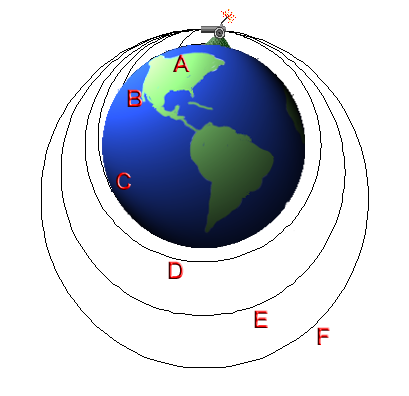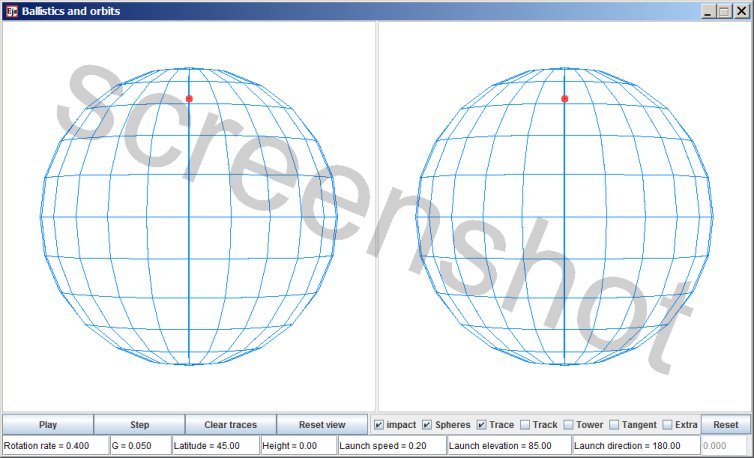The rotation of Earth effect for ballistics
The simulation displays ballistic trajectories near the Earth. The panel on the left shows the trajectory and its trace with respect to the inertial coordinate system, the panel on the right shows the trajectory and its trace as seen from a point of view that is co-rotating with the Earth. The values for the rotation rate and gravitational acceleration (g) are not preset to match to the circumstances on Earth. Rather, the defaults settings were selected to give a vivid display. Air resistence effects are not included, so the results are valid only for celestial bodies with no atmosphere.
In ballistics, two distinct rotation-of-Earth effects are at play.
| A. | The total velocity after the launch comes from two contributing factors: |
| - The velocity the projectile already had as it was co-rotating with the Earth. | |
| - Additional velocity imparted by the launch. | |
| B. | After the launch the missile/projectile moves along an orbital trajectory. The Earth rotates underneath that trajectory. As seen from a co-rotating point of view there is apparent deflection. |
The simulation can be used to explore the following cases:
- 1. Trajectories of ballistic missiles
- 2. Dropping an object from a tower
- 3. Newton's cannonball thought experiment
1. Trajectories of ballistic missiles
Ballistic missiles use all their propellent in the first minutes of flight, accelerating to enormous speed. By the time the rocket fuel is spent the missile is in space, moving along an orbital trajectory. In the simulation this is simplified as follows: the projectiles receive the launch velocity instantly, as if they are launched from a supergun, a gun that can launch payload thousands of kilometers into space.
With the field 'Elevation' you specify at what angle to the local surface the projectile will be launched, and with the field 'Direction' you specify east (0), north (90), west (180) , south (-90) or any angle in between.
The simulation's default settings are for an westward launch (here, 180 degrees is westward), and the launch is almost straight up in the sky. The panel on the right shows the motion with respect to the Earth, and you can see on the panel to the right that the motion with respect to the Earth is as aimed: to the west.
The left panel shows the motion with respect to the inertial coordinate system. The projectile has so much velocity from co-rotating with the Earth that the actual motion is eastward.
After the launch the projectile is no longer affected by the Earth's rotation. The projectile follows a keplerian orbit, as determined by initial direction, initial velocity and gravitational attraction. The groundtrack of a keplerian orbit is a great circle, and therefore you see the groundtrack deviate to the south of the latitude it was launched from.
You can compare with the no-rotation case. Set the input field 'Rotation rate' to zero. Then an eastward and a westward launch will give trajectories that are mirror images of each other. You can check the checkbox 'Tangent' to see a tangent great circle. When the rotation rate of the planet is zero the groundtracks follow that great circle. When the planet is rotating you see the projectile deviating to the South of that tangent great circle.
Actually, in most cases the trajectory will be somewhat to the north of the tangent great circle. Note however that a projectile that is launched vertical to the local surface (no northward or southward velocity component with respect to the local surface) will never strike the Earth north of the latitude that it started from. The projectile may strike the Earth close to the launch latitude, or even exactly on it, but never north of it.
(That is, on the northern hemisphere, on the southern hemisphere everything is mirrored.)
Relevence of this simulation for external ballistics
Taking the Earth's rotation into account is necessary only in the case of ballistic missiles. Even in the case of long range gunnery or long range rifle shooting the rotation of Earth effect is entirely swamped by other much larger effects, so there is no point in considering it.
However, if you do want to incorporate the Earth's rotation then you must be aware that it matters whether the direction of firing is to the east or to the west. A shot to the east will tend to deviate towards the equator, and a shot that is fired to the west tends to deviate to the equator too!
2. Dropping an object from a tower
If you drop a ball from a high tower, will it strike the Earth exactly at the tower's base?
You can set the 'Height' field to create a high tower. (If the projectile flies off rather than being pulled down you need to lower the rotation rate) In order for the effect to be visible the height must be the equivalent of several thousands of kilometers. You will see that the projectile does not fall parallel to the tower, instead it lands to the east.
Explanation: when the ball is released its motion is from that moment on a ballistic trajectory. A ballistic trajectory is an orbital trajectory. Remove the check from the checkbox 'Impact' to see how the projectile would move if all of the planet's mass would be concentrated in a tiny volume. (Remove the check from the checkbox 'Spheres' to see the complete trajectory.) The trajectory is a keplerian orbit, and in the process of being pulled closer to the planet the angular velocity of the satellite increases. So you can think of the deviation from falling parallel to the tower as an example of conservation of angular momentum.
What if the tower is not located at the equator? The tower co-rotates with the planet: it follows the latitude line. But the groundtrack follows a great circle, so on the northern hemisphere the projectile will strike the planet south of the tower's latitude.
(In practice it is almost impossible to perform this experiment. Even when the balls were dropped in (unused) mineshafts all kinds of precautions had to be taken to avoid any motion of the air in the shaft. For a hundred meter deep shaft the expected effect is in the order of a couple of centimeters.)

The higher the velocity of the cannonball that you fire, the longer it will travel before it impacts. A satellite can be thought of as a projectile with so much velocity that the Earth's surface curves away from it faster than the projectile falls.
3. Newton's cannonball thought experiment
If you fire a cannon from a mountain, then with sufficient velocity the projectile will never strike the Earth. This emphasizes that satellite orbits are to be thought of as falling motion. Satellites are falling all the time.
The input fields
- Rotation rate How fast the planet rotates around its axis.
- g The amount of acceleration towards the planet.
- Latitude The latitude where the trajectory will start.
- Height The altitude of the point of launch/release.
- Launch speed Nozzle velocity of the gun that fires the projectile.
- Launch elevation Angle, in degrees, with respect to the local surface of the launch.
- Launch direction Angle, in degrees, of the launch direction. easward is zero, westward is 180.
- Altitude A non-editable field showing the current altitude of the projectile
Presets
As a starter some presets are available. Checking the box 'Extra' will open a small separate window with a presets section.
The option 'Geostationary orbit' sets up a value of 'g' that makes the simulation model the Earth. The Earth (averaged) radius is 6371 km, and geostationary satellites move along an orbit with a radius of 42164 km. With 'Rotation rate = 0.2' and 'g = 1.44' a height above the surface of 5.62 corresponds to the radius of a geostationary orbit.
The option 'Low Earth orbit' has the same rotation rate and 'g', but the orbit is very close to the surface. You see the object circumnavigating 16 times during one revolution of the planet, just as the low Earth orbiting International Space Station takes about 90 minutes for each circle around the Earth.
Method of computation
The method of computation is numerical analysis: the trajectory of the particle is computed by evaluating differential equations.
First the differential equations are used to calculate the motion with respect to the inertial coordinate, subsequently a coordinate transformation is used to transform the trajectory to motion with respect to the co-rotating coordinate system.
The projectile is subject to a single force: gravity. The trajectory arises from initial position and velocity, with the gravitational effects changing the state of motion of the projectile. For the computation the gravitational force is decomposed in x,y and z-components.
This simulation has been created with EJS
EJS stores the specifications of a simulation in a plain text file, with extension .xml
You can examine how the simulation has been set up by opening the simulation .xml file with EJS.
Download location for the EJS software
Download location for the ballistics and orbits source file
(The file is zipped because a browser will attempt to parse any .xml file.)

This work is licensed under a Creative Commons Attribution-ShareAlike 3.0 Unported License.
Last time this page was modified: June 18 2017
